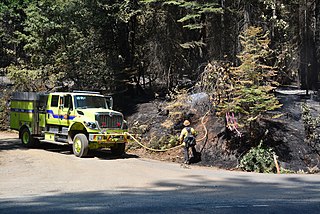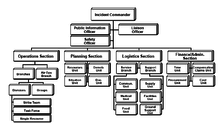
In the United States, community emergency response team (CERT) can refer to
Continuity of Operations (COOP) is a United States federal government initiative, required by U.S. Presidential Policy Directive 40 (PPD-40), to ensure that agencies are able to continue performance of essential functions under a broad range of circumstances. PPD-40 specifies certain requirements for continuity plan development, including the requirement that all federal executive branch departments and agencies develop an integrated, overlapping continuity capability, that supports the eight National Essential Functions (NEFs) described in the document.

The Federal Emergency Management Agency (FEMA) is an agency of the United States Department of Homeland Security (DHS), initially created under President Jimmy Carter by Presidential Reorganization Plan No. 3 of 1978 and implemented by two Executive Orders on April 1, 1979. The agency's primary purpose is to coordinate the response to a disaster that has occurred in the United States and that overwhelms the resources of local and state authorities. The governor of the state in which the disaster occurs must declare a state of emergency and formally request from the President that FEMA and the federal government respond to the disaster. The only exception to the state's gubernatorial declaration requirement occurs when an emergency or disaster takes place on federal property or to a federal asset—for example, the 1995 bombing of the Alfred P. Murrah Federal Building in Oklahoma City, Oklahoma, or the Space Shuttle Columbia in the 2003 return-flight disaster.

The Incident Command System (ICS) is a standardized approach to the command, control, and coordination of emergency response providing a common hierarchy within which responders from multiple agencies can be effective.

Emergency management or disaster management is a science and a system charged with creating the framework within which communities reduce vulnerability to hazards and cope with disasters. Emergency management, despite its name, does not actually focus on the management of emergencies, which can be understood as minor events with limited impacts and are managed through the day-to-day functions of a community. Instead, emergency management focuses on the management of disasters, which are events that produce more impacts than a community can handle on its own. The management of disasters tends to require some combination of activity from individuals and households, organizations, local, and/or higher levels of government. Although many different terminologies exist globally, the activities of emergency management can be generally categorized into preparedness, response, mitigation, and recovery, although other terms such as disaster risk reduction and prevention are also common. The outcome of emergency management is to prevent disasters and where this is not possible, to reduce their harmful impacts.
The New Zealand Co-ordinated Incident Management System (CIMS) is New Zealand's system for managing the response to an incident involving multiple responding agencies. Its developers based the system on California's Incident Command System (ICS) - developed in the 1970s - and on other countries' adaptations of ICS, such as Australia's Australasian Inter-Service Incident Management System (AIIMS).

The National Disaster Medical System (NDMS) is a federally coordinated disaster medical system and partnership of the United States Departments of Health and Human Services (HHS), Homeland Security (DHS), Defense (DOD), and Veterans Affairs (VA). The purpose of the NDMS is to support State, local, Tribal and Territorial authorities following disasters and emergencies by supplementing health and medical systems and response capabilities. NDMS would also support the military and the Department of Veterans Affairs health care systems in caring for combat casualties, should requirements exceed their capacity. The NDMS was established in 1984.
An incident is an event that could lead to loss of, or disruption to, an organization's operations, services or functions. Incident management (IcM) is a term describing the activities of an organization to identify, analyze, and correct hazards to prevent a future re-occurrence. These incidents within a structured organization are normally dealt with by either an incident response team (IRT), an incident management team (IMT), or Incident Command System (ICS). Without effective incident management, an incident can disrupt business operations, information security, IT systems, employees, customers, or other vital business functions.

The National Interagency Fire Center(NIFC) in Boise, Idaho is the American physical facility which is the home to the National Interagency Coordination Center (NICC), and the National Multi-Agency Coordination group (NMAC or MAC).
In the United States, the hospital incident command system (HICS) is an incident command system (ICS) designed for hospitals and intended for use in both emergency and non-emergency situations. It provides hospitals of all sizes with tools needed to advance their emergency preparedness and response capability—both individually and as members of the broader response community.

The United States’ Emergency Management Institute (EMI), of the United States Federal Emergency Management Agency (FEMA), serves as the United States’ focal point for the development and delivery of emergency management training. The emergency management training improves the capabilities of state, territorial, local, and tribal government officials; volunteer organizations; FEMA's disaster workforce; other Federal agencies; and the public and private sectors to minimize the impact of disasters and emergencies on the American public. EMI curricula are structured to meet the needs of this diverse audience, with an emphasis on separate organizations working together in all-hazards emergencies to save lives and protect property. Particular emphasis is placed on governing doctrine, such as, the National Response Framework (NRF), National Incident Management System (NIMS), and the National Preparedness Guidelines. EMI is fully accredited by the International Association for Continuing Education and Training (IACET) and the American Council on Education (ACE). The instruction is based upon the principles of Emergency Management and instructional systems design. This instruction creates a framework within whole community to reduce vulnerability to hazards and to cope with disasters. EMI develops courses and implements training delivery systems to include residential onsite training; offsite delivery in partnership with Emergency Management training systems, colleges, and universities; and technology-based mediums to conduct individual training courses for Emergency Management and Response personnel across the United States.

The Oklahoma Office of Homeland Security (OKOHS) is an agency of State of Oklahoma that is responsible for reducing the State's vulnerability to acts of terrorism and for minimizing and recovering the damage caused by terrorist attacks. OKOHS is a division of the Oklahoma Department of Public Safety.
The United States National Response Framework (NRF) is part of the National Strategy for Homeland Security that presents the guiding principles enabling all levels of domestic response partners to prepare for and provide a unified national response to disasters and emergencies. Building on the existing National Incident Management System (NIMS) as well as Incident Command System (ICS) standardization, the NRF's coordinating structures are always in effect for implementation at any level and at any time for local, state, and national emergency or disaster response.

FIRESCOPE is a system for efficient interagency resource coordination system for fire and other emergencies in the southern California region of the United States. It was developed after a bout of massive wildfires in southern California in 1970 that burned for days and involved multiple jurisdictions.
Defense Support of Civil Authorities (DSCA) is the process by which United States military assets and personnel can be used to assist in missions normally carried out by civil authorities. These missions have included: responses to natural and man-made disasters, law enforcement support, special events, and other domestic activities. A recent example of the use of DSCA is the military response to Hurricane Katrina. DSCA is the overarching guidance of how the United States military can be requested by a federal agency and the procedures that govern the actions of the military during employment.
The California Governor's Office of Emergency Services is a California cabinet-level office responsible for overseeing and coordinating emergency preparedness, response, recovery and homeland security activities within the state. The agency was created by AB 38 (2008), superseding both the Office of Emergency Services (OES) and Office of Homeland Security (OHS).

A mass casualty incident describes an incident in which emergency medical services resources, such as personnel and equipment, are overwhelmed by the number and severity of casualties. For example, an incident where a two-person crew is responding to a motor vehicle collision with three severely injured people could be considered a mass casualty incident. The general public more commonly recognizes events such as building collapses, train and bus collisions, plane crashes, earthquakes and other large-scale emergencies as mass casualty incidents. Events such as the Oklahoma City bombing in 1995, the September 11 attacks in 2001, and the Boston Marathon bombing in 2013 are well-publicized examples of mass casualty incidents. The most common types of MCIs are generally caused by terrorism, mass-transportation accidents, fires or natural disasters. A multiple casualty incident is one in which there are multiple casualties. The key difference from a mass casualty incident is that in a multiple casualty incident the resources available are sufficient to manage the needs of the victims. The issue of resource availability is therefore critical to the understanding of these concepts. One crosses over from a multiple to a mass casualty incident when resources are exceeded and the systems are overwhelmed.
Emergency management software is the software used by local, state and federal emergency management personnel to deal with a wide range of disasters and can take many forms. For example, training software such as simulators are often used to help prepare first responders, word processors can keep form templates handy for printing and analytical software can be used to perform post-hoc examinations of the data captured during an incident. All of these systems are interrelated, as the results of an after-incident analysis can then be used to program training software to better prepare for a similar situation in the future. Crisis Information Management Software (CIMS) is the software found in emergency management operation centers (EOC) that supports the management of crisis information and the corresponding response by public safety agencies.

National Response Scenario Number One is the United States federal government's planned response to a small scale nuclear attack. It is one of the National Response Scenarios developed by the United States Department of Homeland Security, considered the most likely of fifteen emergency scenarios to impact the United States. The Scenarios are related to the National Response Framework (NRF), which describes the structures and mechanisms of a response and the National Incident Management System (NIMS) that gives a framework to orchestrate emergency management. The scenario anticipates terrorists detonating a single, 10 kiloton weapon in a major city, as opposed to a full-scale nuclear war, in which a foreign power such as Russia or China would detonate hundreds or thousands of weapons.

The 1st Air Support Group of the Puerto Rico State Guard (1ASG-PRSG) is the main unit of the State Guard of the Military Forces of Puerto Rico that operates under the sole authority of the governor of Puerto Rico who, in turn, delegates such authority to the Puerto Rico Adjutant General and to the Commanding General of the Puerto Rico State Guard.












